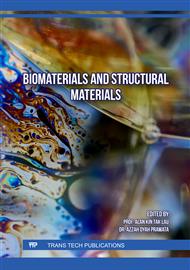[1]
N. A. S. Mohd Pu'ad, P. Koshy, H. Z. Abdullah, M. I. Idris, and T. C. Lee, "Syntheses of hydroxyapatite from natural sources," Heliyon, vol. 5, no. 5, p. e01588, 2019.
DOI: 10.1016/j.heliyon.2019.e01588
Google Scholar
[2]
M. Safarzadeh, C. F. Chee, S. Ramesh, and M. N. A. Fauzi, "Effect of sintering temperature on the morphology, crystallinity and mechanical properties of carbonated hydroxyapatite (CHA)," Ceram. Int., vol. 46, no. 17, p.26784–26789, 2020.
DOI: 10.1016/j.ceramint.2020.07.153
Google Scholar
[3]
D. J. Patty, A. D. Nugraheni, I. D. Ana, and Y. Yusuf, "Dual functional carbonate-hydroxyapatite nanocomposite from Pinctada maxima and egg-white for bone tissue engineering," J. Biomater. Sci. Polym. Ed., vol. 33, no. 8, p.1043–1062, 2022.
DOI: 10.1080/09205063.2022.2036934
Google Scholar
[4]
I. K. Januariyasa and Y. Yusuf, "Porous carbonated hydroxyapatite-based scaffold using simple gas foaming method," J. Asian Ceram. Soc., vol. 8, no. 3, p.634–641, Jul. 2020.
DOI: 10.1080/21870764.2020.1770938
Google Scholar
[5]
R. Wati and Y. Yusuf, "Effect of sintering temperature on carbonated hydroxyapatite derived from common cockle shells (Cerastodermaedule): Composition and crystal characteristics," Key Eng. Mater., vol. 818 KEM, p.37–43, 2019.
DOI: 10.4028/www.scientific.net/KEM.818.37
Google Scholar
[6]
R. Wati and Y. Yusuf, "Carbonated Hydroxyapatite Derived from Cerastoderma edule, Paphia undulata, and Meretrix meretrix Shells," IOP Conf. Ser. Mater. Sci. Eng., vol. 546, no. 4, p.1–8, 2019.
DOI: 10.1088/1757-899X/546/4/042049
Google Scholar
[7]
M. Sari and Y. Yusuf, "Synthesis and characterization of hydroxyapatite based on green mussel shells (perna viridis) with the variation of stirring time using the precipitation method," IOP Conf. Ser. Mater. Sci. Eng., vol. 432, no. 1, 2018.
DOI: 10.1088/1757-899X/432/1/012046
Google Scholar
[8]
H. A. Permatasari, M. Sari, Aminatun, T. Suciati, K. Dahlan, and Y. Yusuf, "Nano-carbonated hydroxyapatite precipitation from abalone shell (Haliotis asinina) waste as the bioceramics candidate for bone tissue engineering," Nanomater. Nanotechnol., vol. 11, p.1–9, 2021.
DOI: 10.1177/18479804211032851
Google Scholar
[9]
R. M. Anggraini and Y. Yusuf, "The Effect of Stirring Time on the Characteristics of Carbonated Hydroxyapatite from Pearl Shells (Pinctada maxima)," IOP Conf. Ser. Mater. Sci. Eng., vol. 546, no. 4, 2019.
DOI: 10.1088/1757-899X/546/4/042002
Google Scholar
[10]
V. J. Mawuntu and Y. Yusuf, "Porous-structure engineering of hydroxyapatite-based scaffold synthesized from Pomacea canaliculata shell by using polyethylene oxide as polymeric porogen," IOP Conf. Ser. Mater. Sci. Eng., vol. 432, no. 1, 2018.
DOI: 10.1088/1757-899X/432/1/012045
Google Scholar
[11]
S. Habibie et al., "Production and Characterization of Hydroxyapatite Bone Substitute Material Performed from Indonesian Limestone," Int. J. Biomed. Eng. Sci., vol. 4, no. 1, p.11–23, 2017.
DOI: 10.5121/ijbes.2017.4102
Google Scholar
[12]
J. Klinkaewnarong and S. Utara, "Ultrasonic-assisted conversion of limestone into needle-like hydroxyapatite nanoparticles," Ultrason. Sonochem., vol. 46, p.18–25, 2018.
DOI: 10.1016/j.ultsonch.2018.04.002
Google Scholar
[13]
T. Ghassemi, A. Shahroodi, M. H. Ebrahimzadeh, A. Mousavian, J. Movaffagh, and A. Moradi, "Current concepts in scaffolding for bone tissue engineering," Arch. Bone Jt. Surg., vol. 6, no. 2, p.90–99, 2018.
Google Scholar
[14]
Z. Huan, J. Chang, and J. Zhou, "Low-temperature fabrication of macroporous scaffolds through foaming and hydration of tricalcium silicate paste and their bioactivity," J. Mater. Sci., vol. 45, no. 4, p.961–968, 2010.
DOI: 10.1007/s10853-009-4026-2
Google Scholar
[15]
T. T. Demirtaş, G. Kaynak, and M. Gumuşderelioʇlu, "Bone-like hydroxyapatite precipitated from 10×SBF-like solution by microwave irradiation," Mater. Sci. Eng. C, vol. 49, p.713–719, 2015.
DOI: 10.1016/j.msec.2015.01.057
Google Scholar
[16]
N. Z. Shaban, M. Y. Kenawy, N. A. Taha, M. M. A. El-Latif, and D. A. Ghareeb, "Synthesized nanorods hydroxyapatite by microwave-assisted technology for in vitro osteoporotic bone regeneration through wnt/β-catenin pathway," Materials (Basel)., vol. 14, no. 19, 2021.
DOI: 10.3390/ma14195823
Google Scholar
[17]
Y. F. Shao, X. Qing, Y. Peng, H. Wang, Z. Shao, and K. Q. Zhang, "Enhancement of mechanical and biological performance on hydroxyapatite/silk fibroin scaffolds facilitated by microwave-assisted mineralization strategy," Colloids Surfaces B Biointerfaces, vol. 197, p.111401, 2021.
DOI: 10.1016/j.colsurfb.2020.111401
Google Scholar
[18]
M. Riaz, R. Zia, A. Ijaz, T. Hussain, M. Mohsin, and A. Malik, "Synthesis of monophasic Ag doped hydroxyapatite and evaluation of antibacterial activity," Mater. Sci. Eng. C, vol. 90, p.308–313, 2018.
DOI: 10.1016/j.msec.2018.04.076
Google Scholar
[19]
E. Landi, A. Tampieri, G. Celotti, and S. J. Sprio, "Densification Behavior and Mechanisms of Synthetic Hydroxyapatite," J. Eur. Ceram. Soc. - J EUR CERAM SOC, vol. 20, p.2377–2387, 2000.
DOI: 10.1016/S0955-2219(00)00154-0
Google Scholar
[20]
E. A. Ofudje, F. Akinwunmi, E. F. Sodiya, S. O. Alayande, A. A. Ogundiran, and G. O. Ajayi, "Biogenic preparation of biphasic calcium phosphate powder from natural source of snail shells: bioactivity study," SN Appl. Sci., vol. 4, no. 5, 2022.
DOI: 10.1007/s42452-022-05025-9
Google Scholar
[21]
K. Haberko et al., "Natural hydroxyapatite - Its behaviour during heat treatment," J. Eur. Ceram. Soc., vol. 26, no. 4–5, p.537–542, 2006.
DOI: 10.1016/j.jeurceramsoc.2005.07.033
Google Scholar
[22]
N. A. Sajahan and W. M. A. Wan Ibrahim, "Microwave irradiation of nanohydroxyapatite from chicken eggshells and duck eggshells," Sci. World J., vol. 2014, 2014.
DOI: 10.1155/2014/275984
Google Scholar
[23]
I. K. Januariyasa, I. D. Ana, and Y. Yusuf, "Nanofibrous poly(vinyl alcohol)/chitosan contained carbonated hydroxyapatite nanoparticles scaffold for bone tissue engineering," Mater. Sci. Eng. C, vol. 107, no. March 2019, p.110347, 2020.
DOI: 10.1016/j.msec.2019.110347
Google Scholar
[24]
I. K. Januariyasa and Y. Yusuf, "Carbonated hydroxyapatite derived from snail shells (Pilla ampulacea): The influence of sintering temperature on purity and crystallography properties," Mater. Sci. Forum, vol. 975 MSF, p.82–87, 2020.
DOI: 10.4028/www.scientific.net/MSF.975.82
Google Scholar
[25]
S. F. Mansour, S. I. El-Dek, and M. K. Ahmed, "Physico-mechanical and morphological features of zirconia substituted hydroxyapatite nano crystals," Sci. Rep., vol. 7, no. March, p.1–21, 2017.
DOI: 10.1038/srep43202
Google Scholar
[26]
B. Smith, Infrared spectral interpretation: A systematic approach, 1st Editio., vol. 36, no. 10. Boca Raton: CRC Press, 2018.
Google Scholar
[27]
N. Bano, S. S. Jikan, H. Basri, S. Adzila, and D. M. Zago, "XRD and FTIR study of A&B type carbonated hydroxyapatite extracted from bovine bone," AIP Conf. Proc., vol. 2068, no. February, 2019.
DOI: 10.1063/1.5089399
Google Scholar



